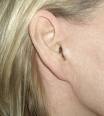
But some of the most telltale signs of having had a facelift occur later…and many patients are not aware that they even exist. These delayed signs are the result of either visible scarring or distortion of the ear or surrounding hairline.


If you carefully look at how the earlobe attaches to the face, there are two ways it can occur. The earlobe can swoop upward as it attaches to the face creating an inverted V union. Or it can be where the earlobe attaches directly to the face without a break in the transition. How the earlobe attaches to the face partially determines the risk of a pixie earlobe deformity after facelift surgery. Direct attachment to the face places the earlobe at a higher riskafter a facelift.
The way to prevent a pixie ear is to use a cradling technique as part of the facelift procedure. This means the lifted skin is advanced upward under the released earlobe and secured. Then the earlobe is reattached either by making a pilot cut in the underlying skin or to close the released edge of the earlobe before suturing it back down. Either way, there is a good chance that the earlobe will look more detached from the side of the face than before surgery. In my Indianapolis plastic surgery practice, I inform all my facelift patients that their earlobes will look initially a little different because of this change. But they will settle down and resume a more normal appearance within weeks. This is the best way to avoid the late telltale sign of the pixie ear, particularly when there is a direct attachment to the face.
If you have a pixie ear deformity, there really is only one way to correct it. It will require a secondary tuck-up facelift to advance skin back up under the earlobe. This uses the old earlobe and some part of the incision going along the back of the ear. The facial skin can then be cradled and the earlobe can then be shortened and reattached with a more normal configuration. In small pixie ears, it may be possible to manipulate the earlobe only and get a shortened and more detached appearance.
Dr. Barry Eppley
Indianapolis, Indiana


